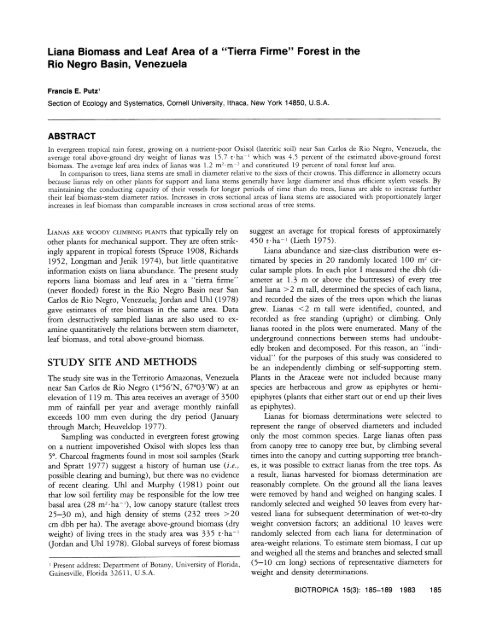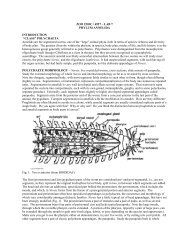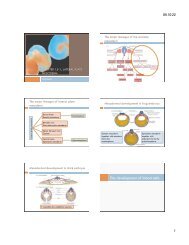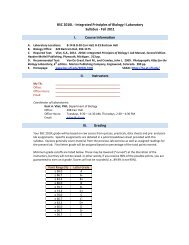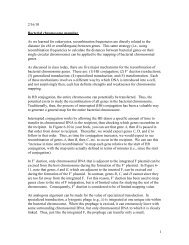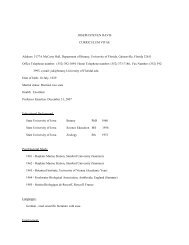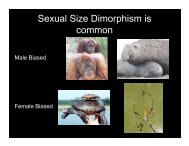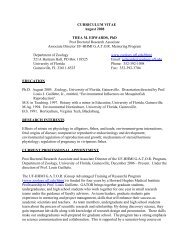Liana Biomass and Leaf Area of a "Tierra Firme" Forest in the Rio ...
Liana Biomass and Leaf Area of a "Tierra Firme" Forest in the Rio ...
Liana Biomass and Leaf Area of a "Tierra Firme" Forest in the Rio ...
You also want an ePaper? Increase the reach of your titles
YUMPU automatically turns print PDFs into web optimized ePapers that Google loves.
<strong>Liana</strong> <strong>Biomass</strong> <strong>and</strong> <strong>Leaf</strong> <strong>Area</strong> <strong>of</strong> a "<strong>Tierra</strong> Firme" <strong>Forest</strong> <strong>in</strong> <strong>the</strong><br />
<strong>Rio</strong> Negro Bas<strong>in</strong>, Venezuela<br />
Francis E. Putzl<br />
Section <strong>of</strong> Ecology <strong>and</strong> Systematics, Cornell University, Ithaca, New York 14850, U.S.A.<br />
ABSTRACT<br />
In evergreen tropical ra<strong>in</strong> forest, grow<strong>in</strong>g on a nutrient-poor Oxisol (lateritic soil) near San Carlos de <strong>Rio</strong> Negro, Venezuela, <strong>the</strong><br />
average total above-ground dry weight <strong>of</strong> lianas was 15.7 t ha-I which was 4.5 percent <strong>of</strong> <strong>the</strong> estimated above-ground forest<br />
biomass. The average leaf area <strong>in</strong>dex <strong>of</strong> lianas was 1.2 M2 m-2 <strong>and</strong> constituted 19 percent <strong>of</strong> total forest leaf area.<br />
In comparison to trees, liana stems are small <strong>in</strong> diameter relative to <strong>the</strong> sizes <strong>of</strong> <strong>the</strong>ir crowns. This difference <strong>in</strong> allometry occurs<br />
because lianas rely on o<strong>the</strong>r plants for support <strong>and</strong> liana stems generally have large diameter <strong>and</strong> thus efficient xylem vessels. By<br />
ma<strong>in</strong>ta<strong>in</strong><strong>in</strong>g <strong>the</strong> conduct<strong>in</strong>g capacity <strong>of</strong> <strong>the</strong>ir vessels for longer periods <strong>of</strong> time than do trees, lianas are able to <strong>in</strong>crease fur<strong>the</strong>r<br />
<strong>the</strong>ir leaf biomass-stem diameter ratios. Increases <strong>in</strong> cross sectional areas <strong>of</strong> liana stems are associated with proportionately larger<br />
<strong>in</strong>creases <strong>in</strong> leaf biomass than comparable <strong>in</strong>creases <strong>in</strong> cross sectional areas <strong>of</strong> tree stems.<br />
LIANAS ARE WOODY CLIMBING PLANTS that typically rely on suggest an average for tropical forests <strong>of</strong> approximately<br />
o<strong>the</strong>r plants for mechanical support. They are <strong>of</strong>ten strik- 450 trha-' (Lieth 1975).<br />
<strong>in</strong>gly apparent <strong>in</strong> tropical forests (Spruce 1908, Richards <strong>Liana</strong> abundance <strong>and</strong> size-class distribution were es-<br />
1952, Longman <strong>and</strong> Jenik 1974), but little quantitative timated by species <strong>in</strong> 20 r<strong>and</strong>omly located 100 m2 cir<strong>in</strong>formation<br />
exists on liana abundance. The present study cular sample plots. In each plot I measured <strong>the</strong> dbh (direports<br />
liana biomass <strong>and</strong> leaf area <strong>in</strong> a "tierra firme" ameter at 1.3 m or above <strong>the</strong> buttresses) <strong>of</strong> every tree<br />
(never flooded) forest <strong>in</strong> <strong>the</strong> <strong>Rio</strong> Negro Bas<strong>in</strong> near San <strong>and</strong> liana >2 m tall, determ<strong>in</strong>ed <strong>the</strong> species <strong>of</strong> each liana,<br />
Carlos de <strong>Rio</strong> Negro, Venezuela; Jordan <strong>and</strong> Uhl (1978) <strong>and</strong> recorded <strong>the</strong> sizes <strong>of</strong> <strong>the</strong> trees upon which <strong>the</strong> lianas<br />
gave estimates <strong>of</strong> tree biomass <strong>in</strong> <strong>the</strong> same area. Data grew. <strong>Liana</strong>s
TABLE 1. <strong>Liana</strong>s used <strong>in</strong> biomass regressions.<br />
Stem<br />
diam-<br />
eter<br />
Species Family (cm)<br />
Abuta rufescens Menispermaceae 12.0<br />
Abuta rufescens Menispermaceae 8.9<br />
Apocynaceae sp. Apocynaceae 1.2<br />
Cayaponia coriaceae Cucurbitaceae 2.4<br />
Coccoloba sp. Polygonaceae 2.3<br />
Derris sp. Legum<strong>in</strong>osae 0.9<br />
Doliocarpus dentatus Dilleniaceae 8.3<br />
Doliocarpus dentatus Dilleniaceae 3.6<br />
Gnetum nodiflorum<br />
G. schwackeanum<br />
G. schwackeanum<br />
Gnetaceae<br />
Gnetaceae<br />
Gnetaceae<br />
1.2<br />
5.2<br />
8.2<br />
Icac<strong>in</strong>aceae sp. Icac<strong>in</strong>aceae 2.6<br />
Menispermaceae sp. Menispermaceae 3.4<br />
Peritassa laevigata Hippocrateaceae 9.1<br />
Peritassa laevigata Hippocrateaceae 4.1<br />
Pseudoconnarus macrophyllus Connaraceae 1.8<br />
Pseudoconnarus macrophyllus Connaraceae 2.7<br />
High liana species richness <strong>and</strong> rarity <strong>of</strong> many liana<br />
species made it impractical to develop allometric regrestwo,<br />
6 carried three, 4 carried four, 0 carried five, 3<br />
sions for each species. Consequently, I developed a mixedcarried<br />
six, <strong>and</strong> 1 carried seven lianas; compar<strong>in</strong>g <strong>the</strong><br />
species regression based on a total <strong>of</strong> 17 <strong>in</strong>dividuals repobserved<br />
between-tree distribution <strong>of</strong> lianas with Poisson<br />
resent<strong>in</strong>g <strong>the</strong> 12 most common species (Table 1).<br />
probabilities, it is clear that trees with at least one liana<br />
have a higher than r<strong>and</strong>om probability <strong>of</strong> hav<strong>in</strong>g more<br />
RESULTS AND DISCUSSION<br />
than one liana (x2 = 31.9; P < .001). Trees <strong>of</strong> some<br />
species are particularly prone to liana <strong>in</strong>festation, <strong>and</strong> sus-<br />
In 20 sample plots cover<strong>in</strong>g a total <strong>of</strong> 0.2 ha I encoun- pended lianas resemble trellises that provide ready access<br />
tered 45 species <strong>of</strong> lianas (Fig. 1). An average <strong>of</strong> 34.5 to <strong>the</strong> canopy for o<strong>the</strong>r lianas.<br />
<strong>in</strong>dividuals (SD = 9.8) <strong>of</strong> 11.4 species (SD = 2.2) grew For <strong>the</strong> purpose <strong>of</strong> predict<strong>in</strong>g total liana above-ground<br />
<strong>in</strong> each plot; 39 percent <strong>of</strong> <strong>the</strong>se were self-support<strong>in</strong>g dry weights I chose <strong>the</strong> logarithm (log,0) <strong>of</strong> basal area as<br />
(upright). Self-support<strong>in</strong>g lianas constituted 20 percent <strong>the</strong> <strong>in</strong>dependent variable because it is <strong>the</strong> most convenient<br />
(SD = 9) <strong>of</strong> <strong>the</strong> total number <strong>of</strong> woody plants
F 100<br />
log y =0.12 +0.91 log x<br />
R2 0.8185<br />
<strong>the</strong> Oxisol site <strong>in</strong> San Carlos is an Amazon caat<strong>in</strong>ga (heath)<br />
forest on a well developed Spodosol (tropaquod). This<br />
forest has a lower canopy <strong>and</strong> lower species diversity than<br />
<strong>the</strong> Oxisol site <strong>and</strong> is characterized by trees with sclerophylls<br />
<strong>and</strong> a paucity <strong>of</strong> lianas (Kl<strong>in</strong>ge <strong>in</strong> press). Davis<br />
<strong>and</strong> Richards (1934) observed a similar lack <strong>of</strong> lianas <strong>in</strong><br />
=0 _<br />
F-0~~~~~~~~~<br />
_>/<br />
_ 0<br />
0@<br />
heath forests <strong>in</strong> Guyana; Richards (1936) found a similar<br />
contrast <strong>in</strong> abundance <strong>of</strong> lianas <strong>in</strong> heath forest grow<strong>in</strong>g<br />
on white s<strong>and</strong> <strong>and</strong> <strong>in</strong> mixed forest grow<strong>in</strong>g on clay loam<br />
<strong>in</strong> Borneo. This contrast, as Richards (1952) suggests,<br />
may be due to xeric conditions <strong>in</strong> <strong>the</strong> understories <strong>of</strong> heath<br />
0~~~~<br />
forests. However, lianas are <strong>of</strong>ten common <strong>in</strong> forests which<br />
suffer pronounced dry seasons (Holdridge et al. 1971).<br />
m 0 /<br />
Low soil fertility may also partly expla<strong>in</strong> <strong>the</strong> paucity <strong>of</strong><br />
lianas <strong>in</strong> heath forests (Janzen 1974), but, surpris<strong>in</strong>gly,<br />
10 100 <strong>the</strong> analysis <strong>of</strong> <strong>the</strong> Oxisol <strong>and</strong> <strong>of</strong> <strong>the</strong> Spodosol from San<br />
BASAL AREA LIANAS (cm2) Carlos showed little difference <strong>in</strong> <strong>the</strong> concentration <strong>of</strong> ma-<br />
FIGURE 2. Total above ground dry weight <strong>of</strong> lianas as a<br />
function <strong>of</strong> stem basal area at 1.3 m from <strong>the</strong> ground (logl0).<br />
jor nutrients. The dependence <strong>of</strong> lianas on treefall disturbances<br />
(Webb 1958, Putz 1982) suggests that <strong>the</strong> apparently<br />
lower tree mortality rates on <strong>the</strong> Spodosol (pers.<br />
obs.) may be a factor contribut<strong>in</strong>g to <strong>the</strong> lower abundance<br />
<strong>of</strong> lianas. High frequency <strong>of</strong> disturbance may be <strong>the</strong> exleaf<br />
weight ratio, weighted on <strong>the</strong> basis <strong>of</strong> species biomass planation for <strong>the</strong> super-abundance <strong>of</strong> lianas observed <strong>in</strong><br />
<strong>in</strong> <strong>the</strong> 20 sample plots, was 118 cm2 g-1. Jordan <strong>and</strong> Gabon (Hladik 1974) <strong>in</strong> a forest well known for its<br />
Uhl (1978) reported a figure <strong>of</strong> 65 cm2 g- for trees <strong>in</strong> elephants (E. G. Leigh, pers. comm.).<br />
<strong>the</strong> same forest.<br />
Allometric relationships between stem cross sectional<br />
Wood densities <strong>of</strong> <strong>the</strong> 45 liana species encountered area <strong>and</strong> leaf biomass (or leaf area) for trees <strong>and</strong> lianas<br />
varied from 0.31 to 0.95 g.cm-3. Average wood density, are very different; total dry weight <strong>of</strong> leaves <strong>in</strong>creased<br />
weighted on <strong>the</strong> basis <strong>of</strong> estimated species biomass <strong>in</strong> <strong>the</strong> much more rapidly with stem basal area <strong>in</strong> lianas than <strong>in</strong><br />
sample plots was 0.48 g-cm-3; Jordan <strong>and</strong> Uhl (1978) trees (Fig. 3). <strong>Liana</strong> stems can be small <strong>in</strong> diameter relreported<br />
a value <strong>of</strong> 0.96 g cm-3 for average tree wood ative to <strong>the</strong> amount <strong>of</strong> foliage supplied (Schenck 1892,<br />
density <strong>in</strong> <strong>the</strong> same forest. <strong>Liana</strong> abundance varies from Schimper <strong>and</strong> von Faber 1938, Schnell 1970) because<br />
forest to forest but <strong>in</strong> a "tierra firme" forest <strong>in</strong> Brazil, a lianas do not support <strong>the</strong>mselves mechanically <strong>and</strong> beseasonal<br />
evergreen forest <strong>in</strong> Thail<strong>and</strong>, <strong>and</strong> a ra<strong>in</strong> forest <strong>in</strong> cause lianas generally have very efficient xylem vessels.<br />
Ghana, lianas were similar <strong>in</strong> <strong>the</strong>ir abundance to <strong>the</strong> Ox- For a tree to avoid buckl<strong>in</strong>g under its own weight, each<br />
isol site <strong>in</strong> Venezuela (Table 2). Immediately adjacent to height or weight <strong>in</strong>crement must be balanced by a pro-<br />
TABLE 2. <strong>Biomass</strong> <strong>and</strong> leaf area <strong>in</strong>dex (LAI) <strong>of</strong> lianas <strong>and</strong> trees <strong>in</strong> several tropical forests.<br />
Total<br />
above-ground<br />
dry-weight<br />
<strong>in</strong>clud<strong>in</strong>g <strong>Liana</strong><br />
lianas dry-weight LAI<br />
Location <strong>Forest</strong> type (t ha-') (t ha-1) Trees <strong>Liana</strong>s Reference<br />
Brazil <strong>Tierra</strong> Firme 687a 46^ Kl<strong>in</strong>ge <strong>and</strong> Rodrigues<br />
1974<br />
Thail<strong>and</strong> Seasonal Evergreen 403 20 7.4 3.3 Ogawa et al. 1965<br />
Ghana Tropical Ra<strong>in</strong> 308 14 Greenl<strong>and</strong> <strong>and</strong> Kowal<br />
1960<br />
Venezuela Amazon Caat<strong>in</strong>ga 309 2.1 Kl<strong>in</strong>ge, <strong>in</strong> press<br />
Malaysia High Dipterocarp 475 9 7.3 0.7 Kato et al. 1978<br />
Venezuela <strong>Tierra</strong> Firme 351 15 5.2 1.2 Jordan <strong>and</strong> Uhl 1978;<br />
this study<br />
a Fresh-weight.<br />
<strong>Liana</strong> <strong>Biomass</strong> <strong>and</strong> Allometry 187
12<br />
10_.<br />
I-<br />
YIianas= 0 109x - 0.376<br />
0.008<br />
Ytrees =1.368 + 0.018x<br />
0.004<br />
/<br />
I<br />
I<br />
area <strong>of</strong> even large lianas is functional xylem. It is unlikely<br />
that <strong>the</strong> lack <strong>of</strong> non-conduct<strong>in</strong>g xylem is due to <strong>the</strong> lianas<br />
grow<strong>in</strong>g more rapidly <strong>in</strong> diameter than trees because <strong>the</strong><br />
average annual stem diameter growth rate <strong>of</strong> 50 canopy<br />
lianas monitored for 1.5 years <strong>in</strong> San Carlos was approximately<br />
0.5 mm. This extremely slow growth rate coupled<br />
LL<br />
8_/<br />
with <strong>the</strong> lack <strong>of</strong> heartwood formation suggests that xylem<br />
vessels <strong>in</strong> lianas ma<strong>in</strong>ta<strong>in</strong> conduct<strong>in</strong>g capacity for decades.<br />
06<br />
IL<br />
LLi<br />
J4<br />
A<br />
A<br />
A<br />
To rema<strong>in</strong> functional for such long periods <strong>of</strong> time,<br />
liana vessels ei<strong>the</strong>r do not cavitate (develop embolisms)<br />
or somehow cavitated vessels are refilled. Consider<strong>in</strong>g that<br />
most lianas grow on top <strong>of</strong> trees (i.e., <strong>in</strong> full sun) <strong>and</strong><br />
generally have large th<strong>in</strong> leaves, liana stems must expe-<br />
C] - 6<br />
02<br />
H-<br />
/A<br />
A<br />
rience high transpirational dem<strong>and</strong>s <strong>and</strong> consequently high<br />
risks <strong>of</strong> vessel cavitation. Fur<strong>the</strong>rmore, liana stems are<br />
S A<br />
<strong>of</strong>ten physically jostled about; such mechanical distur-<br />
0<br />
20 40 60 80 100<br />
BASAL AREA<br />
120 140<br />
bances may also result <strong>in</strong> vessel cavitation. Thus it seems<br />
more likely that cavitated vessels <strong>in</strong> lianas can be repaired<br />
ra<strong>the</strong>r than avoid cavitation <strong>in</strong> <strong>the</strong> first place.<br />
FIGURE 3. Total dry weight <strong>of</strong> harvested trees (triangles) <strong>and</strong> Root pressure (see Stock<strong>in</strong>g 1956 for a review) may<br />
lianas (dots) plotted aga<strong>in</strong>st stem basal area at 1.3 m from <strong>the</strong> provide <strong>the</strong> necessary force for refill<strong>in</strong>g cavitated xylem<br />
ground.<br />
vessels. The first published account <strong>of</strong> root pressure was<br />
a description <strong>of</strong> <strong>the</strong> phenomenon <strong>in</strong> grapev<strong>in</strong>es ( Vitis sp.;<br />
Hales 1727); xylem vessels <strong>in</strong> grapes are known to refill<br />
<strong>in</strong> <strong>the</strong> spr<strong>in</strong>g with water pumped up from <strong>the</strong> roots (Schoportional<br />
<strong>in</strong>crease <strong>in</strong> stem basal area (Greenhill 1881, l<strong>and</strong>er et al. 1955). Positive xylem pressures have also<br />
McMahon 1973). When xylem loses its conduct<strong>in</strong>g cabeen<br />
reported for several tropical lianas (Schol<strong>and</strong>er et al.<br />
pacity, it still serves to help mechanically support <strong>the</strong> tree; 1957, 1961). Some temperate herbs refill cavitated vesa<br />
balance is thus ma<strong>in</strong>ta<strong>in</strong>ed between requirements for<br />
sels dur<strong>in</strong>g <strong>the</strong> night when root pressure forces stem water<br />
support <strong>and</strong> supply. Xylem vessels <strong>in</strong> trees reta<strong>in</strong> <strong>the</strong>ir<br />
potential positive (Milburn <strong>and</strong> McLaughl<strong>in</strong> 1974). The<br />
conduct<strong>in</strong>g capacity for a few years at most (Zimmer- hypo<strong>the</strong>sis that root pressure serves to refill cavitated vesmann<br />
<strong>and</strong> Brown 1971); this results <strong>in</strong> a b<strong>and</strong> <strong>of</strong> consels<br />
<strong>in</strong> lianas <strong>and</strong> thus prolongs <strong>the</strong>ir functional life awaits<br />
duct<strong>in</strong>g wood (sapwood) surround<strong>in</strong>g a central core <strong>of</strong><br />
experimental exam<strong>in</strong>ation.<br />
nonconduct<strong>in</strong>g heartwood. A large portion <strong>of</strong> each growth <strong>Liana</strong>s are abundant <strong>in</strong> <strong>the</strong> tierra firme forest <strong>of</strong> San<br />
<strong>in</strong>crement <strong>in</strong> tree stems thus serves to replace noncon- Carlos de <strong>Rio</strong> Negro where <strong>the</strong>y contribute substantially<br />
duct<strong>in</strong>g vessels (Preston 1958). Because lianas rely on to total forest leaf area. Per unit cross-sectional area, liana<br />
trees for support, <strong>the</strong>ir stems need not be resistant to stems support more leaf weight than trees. This is because<br />
bend<strong>in</strong>g. Small diameter liana stems can supply water lianas generally have large diameter <strong>and</strong> long function<strong>in</strong>g<br />
<strong>and</strong> m<strong>in</strong>eral nutrients to many more leaves than tree stems<br />
xylem vessels.<br />
<strong>of</strong> similar diameter partially due to <strong>the</strong> extremely wide<br />
diameter xylem vessels found <strong>in</strong> many liana stems<br />
(Carlquist 1975, Ayensu <strong>and</strong> Stern 1964); flow rates ACKNOWLEDGMENTS<br />
<strong>in</strong>crease with <strong>the</strong> fourth power <strong>of</strong> vessel diameter (Poi- F<strong>in</strong>ancial support for this study was provided by <strong>the</strong> National<br />
seuilles's Law; Zimmermann 1978). The steepness <strong>of</strong> <strong>the</strong> Science Foundation <strong>and</strong> <strong>the</strong> Palm Society. I wish to thank P.<br />
basal-area-leaf-weight relation <strong>in</strong> lianas (Fig. 3) suggests L. Marks, C. Uhl, C. F. Jordan, <strong>and</strong> E. G. Leigh, Jr. for <strong>the</strong>ir<br />
that <strong>in</strong> contrast to trees, each diameter <strong>in</strong>crement <strong>in</strong> liana<br />
generous support <strong>and</strong> numerous helpful suggestions. Howard<br />
<strong>and</strong> Kate Clark were both gracious hosts <strong>and</strong> helpful <strong>in</strong> <strong>the</strong><br />
stems allows a proportionate <strong>and</strong> large <strong>in</strong>crease <strong>in</strong> <strong>the</strong> field. Contribution number 3845, Journal Series, Institute <strong>of</strong><br />
amount <strong>of</strong> leaf biomass supplied. Prelim<strong>in</strong>ary dye move- Food <strong>and</strong> Agricultural Sciences, University <strong>of</strong> Florida.<br />
ment experiments <strong>in</strong>dicate that much <strong>of</strong> <strong>the</strong> cross sectional<br />
LITERATURE CITED<br />
AYENSU, E. S., AND W. L. STERN. 1964. Systematic anatomy <strong>and</strong> ontogeny <strong>of</strong> <strong>the</strong> stem <strong>in</strong> Passifloraceae. Contr. U.S. Nat. Herb.<br />
34: 45-71.<br />
188 Putz
CARLQUIST, S. 1975. Ecological strategies <strong>of</strong> xylem evolution. University <strong>of</strong> California Press, Berkeley.<br />
DAVIS, T. A. W., AND P. W. RICHARDS. 1934. The vegetation <strong>of</strong> Moraballi Creek: An ecological study <strong>of</strong> a limited area <strong>of</strong><br />
tropical ra<strong>in</strong> forest. Part 2. J. Ecol. 22: 106-155.<br />
GREENHILL, G. 1881. Determ<strong>in</strong>ation <strong>of</strong> <strong>the</strong> greatest height consistent with stability that a vertical pole or mast can be made,<br />
<strong>and</strong> <strong>the</strong> greatest height to which a tree <strong>of</strong> given proportions can grow. Proc. Cambridge Phil. Soc. 4: 65-73.<br />
GREENLAND, D. J., AND J. M. L. KOWAL. 1960. Nutrient content <strong>of</strong> <strong>the</strong> moist tropical forest <strong>of</strong> Ghana. Plant <strong>and</strong> Soil 12: 154-<br />
174.<br />
HALES, S. 1727. Vegetable staticks, or an account <strong>of</strong> some statical experiments on <strong>the</strong> sap <strong>in</strong> vegetables. J. Peele, London.<br />
HEUVELDOP, J. 1977. Erste ergebnisse besl<strong>and</strong>esmeleorologischer untersuchungen im regenwald von San Carlos. Mith. Bundesforschunsanstalt<br />
fur Forst und Holzwirtschuft 115: 101-106.<br />
HLADIK, A. 1974. Importance des lianes dans la production foliare de la foret equatoriale du nord-est du Gabon. C. R. Acad.<br />
Sci. Paris 278: 2527-2530.<br />
HOLDRIDGE, L. R., W. C. GRENKE, W. H. HATHEWAY, T. LIANG, AND J. A. TosI, JR. 1971. <strong>Forest</strong> environments <strong>in</strong> tropical life<br />
zones. Pergamon Press, New York.<br />
JANZEN, D. H. 1974. Tropical blackwater rivers, animals, <strong>and</strong> mast fruit<strong>in</strong>g by <strong>the</strong> Dipterocarpaceae. Biotropica 6: 69-103.<br />
JORDAN, C. F., AND C. UHL. 1978. <strong>Biomass</strong> <strong>of</strong> a "tierra firme" forest <strong>of</strong> <strong>the</strong> Amazon Bas<strong>in</strong>. Oecol. Plant. 13: 387-400.<br />
KATO, R., Y. TADAKI, AND H. OGAWA. 1978. Plant biomass <strong>and</strong> growth <strong>in</strong>crement studies <strong>in</strong> Pasoh <strong>Forest</strong>. Malay. Nature J.<br />
30: 211-224.<br />
KLINGE, H. Studies <strong>in</strong> Amazon caat<strong>in</strong>ga forests <strong>in</strong> Sou<strong>the</strong>rn Venezuela. II. Fresh biomass composition <strong>of</strong> tree vegetation <strong>in</strong> Amazon<br />
caat<strong>in</strong>ga near San Carlos de <strong>Rio</strong> Negro. Acta Cientifica Venezolana. (In press).<br />
, AND W. W. RODRIGUES. 1974. Phytomass estimation <strong>in</strong> a central Amazonian ra<strong>in</strong> forest. <strong>Forest</strong> <strong>Biomass</strong> Studies,<br />
I.U.F.R.O. Congress 15.<br />
KNIGHT, D. H. 1975. A phytosociological analysis <strong>of</strong> species rich tropical forest on Barro Colorado Isl<strong>and</strong>, Panama. Ecol. Monogr.<br />
45: 259-284.<br />
LIETH, H. 1975. Primary production <strong>of</strong> <strong>the</strong> major vegetation units <strong>of</strong> <strong>the</strong> world. In R. H. Whittaker <strong>and</strong> H. Lieth (Eds.).<br />
Primary productivity <strong>of</strong> <strong>the</strong> biosphere. Spr<strong>in</strong>ger-Verlag, N.Y.<br />
LONGMAN, K. A., AND J. JENIK. 1974. Tropical forest <strong>and</strong> its environment. Longman, London.<br />
MCMAHON, T. 1973. Size <strong>and</strong> shape <strong>in</strong> biology. Science 179: 1201-1204.<br />
MILBURN, J. A., AND M. E. MCLAUGHLIN. 1974. Studies <strong>of</strong> cavitation <strong>in</strong> isolated vascular bundles <strong>and</strong> whole leaves <strong>of</strong> Plantago<br />
major L. New Phytol. 73: 861-87 1.<br />
MONTGOMERY, G. G., AND M. E. SUNQUIST. 1978. Habitat selection <strong>and</strong> use by two-toed <strong>and</strong> three-toed sloths. In G. G.<br />
Montgomery (Ed.). The ecology <strong>of</strong> arboreal foliovores. Smithsonian Institution Press, Wash<strong>in</strong>gton, D.C.<br />
OGAWA, H., K. YODA, K. OGINO, AND T. KIRA. 1965. Comparative ecological studies on three ma<strong>in</strong> types <strong>of</strong> forest vegetation<br />
<strong>in</strong> Thail<strong>and</strong>. II. Plant biomass. Nature <strong>and</strong> Life <strong>in</strong> Sou<strong>the</strong>ast Asia 4: 49-80.<br />
PRESTON, R. D. 1958. The ascent <strong>of</strong> sap <strong>and</strong> <strong>the</strong> movement <strong>of</strong> soluble carbohydrates <strong>in</strong>stems <strong>of</strong> higher plants. In D. H. Everett<br />
<strong>and</strong> F. S. Stone (Eds.). The structure <strong>and</strong> properties <strong>of</strong> porous materials. Butterworth, London.<br />
PUTZ, F. E. 1982. Natural history <strong>of</strong> lianas <strong>and</strong> <strong>the</strong>ir <strong>in</strong>fluences on tropical forest dynamics. Ph.D. Dissertation, Cornell University,<br />
Ithaca, New York, U.S.A.<br />
RICHARDS, P. W. 1936. Ecological observations on <strong>the</strong> ra<strong>in</strong> forest <strong>of</strong> Mount Dulit, Sarawak. Parts I <strong>and</strong> II. J. Ecol. 24: 1-37;<br />
340-360.<br />
RICHARDS, P. W. 1952. The tropical ra<strong>in</strong> forest: An ecological study. Cambridge University Press, London.<br />
ROLLET, B. 1969. La regeneration naturelle en foret dense humide sempervirente de pla<strong>in</strong>e de la Guayane Venezuelienne. Bois<br />
et For&ts des Tropiques 124: 19-38.<br />
SCHENCK, H. 1892. Beitrage zur Biologie und Anatomie der Lianen. I. Theil. Beitrage zur Biologie der Lianen. Bot. Mitt. Trop.<br />
4: 1-248.<br />
SCHIMPER, A. F. W., AND F. C. VON FABER. 1938. Pflanzengeographie auf physiologischer grundlage. 3e Aufl., le, B<strong>and</strong>, Fisher,<br />
Jena.<br />
SCHNELL, R. 1970. Introduction a la phytogeographie des pays tropicaux. Les problems generaux. Vol. I. Les flores-les structures.<br />
Gauthiers-Villars, Paris.<br />
SCHOLANDER, P. F., W. E. LOVE, AND J. W. KANWISHER. 1955. The rise <strong>of</strong> sap <strong>in</strong> tall grapev<strong>in</strong>es. Plant Physiol. 30: 93-104.<br />
R. RUUD, AND LEIVESTAD. 1957. The rise <strong>of</strong> sap <strong>in</strong> a tropical liana. Plant Physiol. 32: 1-6.<br />
H. HEINMINGSEN, AND W. GAREY. 1961. Cohesive lift <strong>of</strong> sap <strong>in</strong> <strong>the</strong> rattan v<strong>in</strong>e. Science 134: 1835-1838.<br />
SPRUCE, R. 1908. Notes <strong>of</strong> a botanist on <strong>the</strong> Amazon <strong>and</strong> Andes. Ed. by A. R. Wallace. Macmillan <strong>and</strong> Co., London. 2 Vols.<br />
STARK, N., AND M. SPRArr. 1977. Root biomass <strong>and</strong> nutrient storage <strong>in</strong> ra<strong>in</strong> forest oxisols near San Carlos de <strong>Rio</strong> Negro. Trop.<br />
Ecol. 18: 1-9.<br />
STOCKING, C. R. 1956. Root pressure. H<strong>and</strong>b. Pflanzenphysiologie 3: 583-586.<br />
UHL, C., AND P. G. MURPHY. 1981. Composition, structure <strong>and</strong> regeneration <strong>of</strong> a tierra firme forest on <strong>the</strong> Amazon Bas<strong>in</strong> <strong>of</strong><br />
Venezuella. Trop. Ecol. 22: 2 19-237.<br />
WEBB, L. J. 1958. Cyclones as an ecological factor <strong>in</strong> tropical lowl<strong>and</strong> ra<strong>in</strong> forest, North Queensl<strong>and</strong>. Aust. J. Bot. 6: 220-228.<br />
ZIMMERMANN, M. H. 1978. Structural requirements for optimal water conduction <strong>in</strong> tree stems. In P. B. Toml<strong>in</strong>son <strong>and</strong> M. H.<br />
Zimmermann (Eds.). Tropical trees as liv<strong>in</strong>g systems. Cambridge University Press, Cambridge.<br />
, AND C. L. BROWN. 1971. Trees. Structure <strong>and</strong> function. Spr<strong>in</strong>ger-Verlag, New York.<br />
<strong>Liana</strong> <strong>Biomass</strong> <strong>and</strong> Allometry 189


